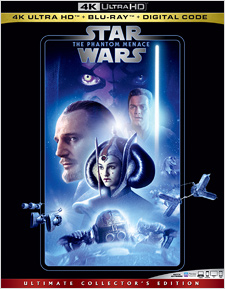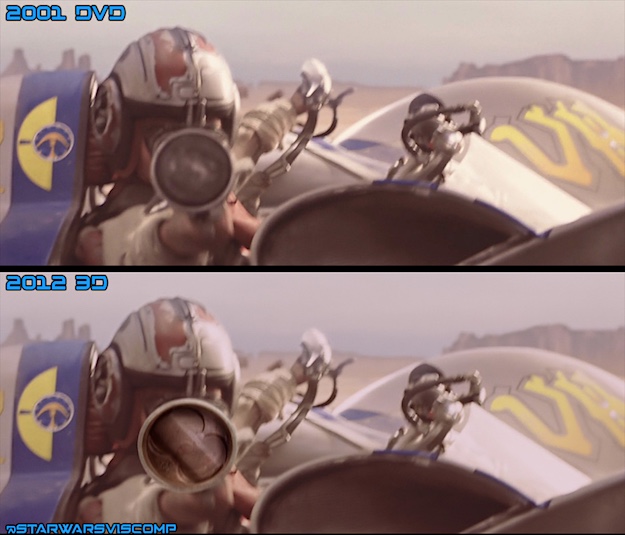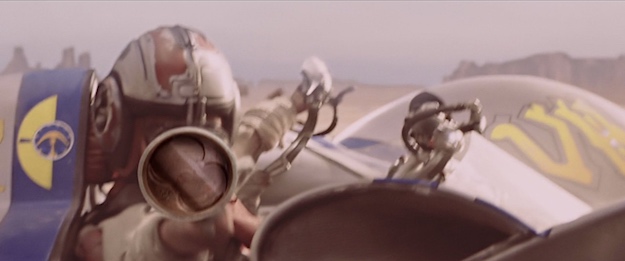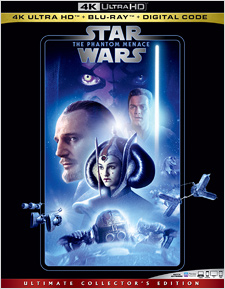Star Wars: The Phantom Menace (4K UHD Review)

Director
George LucasRelease Date(s)
1999 (March 31, 2020)Studio(s)
Lucasfilm/20th Century Fox (Walt Disney Studios)- Film/Program Grade: C
- Video Grade: C
- Audio Grade: A+
- Extras Grade: B-
Review
“Turmoil has engulfed the Galactic Republic. The taxation of trade routes to outlying star systems is in dispute…”
Thirty-two years before the events of the original Star Wars, the Old Republic is in decline. The greedy Trade Federation has blockaded the peaceful planet of Naboo. Its new queen, Padmé Amidala (Natalie Portman), has appealed to the Supreme Chancellor for help, so Jedi Master Qui-Gon Jinn and his apprentice Obi-Wan Kenobi (Liam Neeson and Ewan McGregor) are dispatched to settle the dispute. When the Trade Federation’s droid army invades the planet instead, the Jedi must find a way to protect Amidala and save her people. But their task will not be easy. Plenty of evil is afoot, courtesy of the vile Darth Sidious, a mysterious Sith Lord, and his saber-wielding apprentice Darth Maul. And along the way, our heroes will meet characters new and old, who will shape the destiny of the galaxy, including the droids C-3PO and R2-D2 (Anthony Daniels and Kenny Baker), the Jedi Masters Yoda and Mace Windu (Frank Oz and Samuel L. Jackson), the clumsy Gungan Jar Jar Binks (Ahmed Best), and a young slave boy from Tatooine named Anakin Skywalker (Jake Lloyd), who is unexpectedly strong with the Force.
As the first of three prequel films designed to chronicle the rise and fall of cinema’s greatest villain, Darth Vader, the build-up to The Phantom Menace and the hype surrounding its release was intense. It would have been nearly impossible for any film to meet such lofty expectations, but writer/director George Lucas didn’t help himself here with a script full of tin-eared dialogue, bureaucratic maneuverings, and an unfortunate decision to demystify the Force by explaining it as a side-effect of microbes. The cast is actually quite strong (particularly McGregor), but clearly struggled to bring naturalism to their roles, performing as they were against green screens in virtual environments they couldn’t see. In his usual fashion, Lucas pushed computer-generated VFX to a whole new level with this film, but while the imagery was groundbreaking for its day, its low-resolution looks woefully dated compared to modern FX. What’s more, some of Phantom’s digital creatures—though certainly imaginative—employed speech patterns and accents that bordered on racial and cultural stereotypes. Still, the proceedings are elevated by a dazzling John Williams score and a pair of thrilling set pieces—including a Ben Hur-style podrace and a frenetic three-way lightsaber duel—that go a long way towards papering over the film’s shortcomings.
The production history of The Phantom Menace is a complex one. It was shot mostly on 35 mm photochemical film using Arriflex cameras and Hawk C-Series anamorphic lenses (for an intended aspect ratio of 2.39:1), though it was also one of the first features to utilize footage captured digitally in HDCAM as well (at 1080/24p using the Sony HDC-750—the new Panavision lenses this camera required weren’t ready for principle photography, but were available for re-shoots and second unit photography). Post production was done shot by shot, with original camera negative copied to an interpositive and then to internegative. Footage requiring VFX was scanned at 2K, with VFX produced digitally at sub-2K resolution (state-of-the-art at that time), and the finished shots were printed back out to internegative. The HDCAM footage was likewise printed to internegative. All of this film was then physically edited into a final cut negative, from which a properly color-timed interpositive was created (essentially the finished master element, though an early “Digital Intermediate” was made for pioneering exhibition in theaters by Texas Instruments—presumably a 2K scan of the interpositive). For the film’s original DVD release in 2001, that interpositive was scanned in 10-bit 2K by Lowry Digital, resulting in the creation of a 2K Digital Intermediate (complete with digital VFX tweaks and a color grade supervised by Lucas). This source was used again for the 2011 Blu-ray release, though with a bit more Lowry Digital remastering (and still more digital VFX and color timing tweaks).
For The Phantom Meance’s 3D theatrical release—and to protect Disney’s investment following the studio’s purchase of the Star Wars franchise in 2012—the cut negative (with VFX film-outs) was scanned again in 16-bit 4K by Reliance MediaWorks (formerly Lowry Digital). Lucas once again took the opportunity to tweak the VFX and color timing, resulting in the creation of a new 4K Digital Intermediate. This Ultra HD release (and the recent Disney+ version) was mastered from the 4K DI, with additional color grading for high dynamic range (only HDR10 is available on the disc, but Dolby Vision is available on the Digital version).
Disney’s 4K disc presentation obviously includes all the latest tweaks and changes seen on Disney+ (note that the 20th Century Fox logo remains intact), but the image quality is better on disc. The average datarate is in the 50-60 Mbps range (vs 15-25 Mbps via streaming) and the extra bandwidth results in a somewhat more dimensional image. Obviously, this is not a reference quality 4K presentation. Even the footage actually shot on 35 mm film was processed with DNR to produce a soft, clean look that better matched the HD resolution of the VFX and digitally captured footage. There’s also baked-in edge enhancement in some shots. BUT… since the time of the original 2011 Blu-ray release, upsampling algorithms have improved a great deal. What’s more, with an impressive application of state-of-the-art “film-look” processing, Reliance has managed to produce a 4K DI image that’s… well, not great, but certainly better than I was expecting on UHD. The 4K disc offers a more film-like image than the original Blu-ray. Detail is still soft—often very soft—and some of the VFX shots just have an unavoidably “digital” appearance. But combined with a restrained HDR grade (peak brightness is 1000 nits per the disc’s metadata—keep in mind, there’s only so much color and contrast information in the source to begin with), the result is… let’s call it acceptable. I would certainly rather watch this presentation, as opposed to any other, on the exceedingly rare occasions I’d choose to revisit the film.
Fortunately, The Phantom Menace has always been a sonic tour de force on disc and this new 4K release is no exception. Primary audio is included in English Dolby Atmos. Additional options include English 2.0 Descriptive Audio, Japanese 7.1 Dolby Digital Plus, and French and Spanish 5.1 Dolby Digital, with subtitles available in English for the Hearing Impaired, French, Spanish, and Japanese. Right from the opening shot, the Republic cruiser’s engines have a throaty growl. Bass is robust and muscular, while dialogue is clean and natural. Subtle atmospherics abound throughout the film, from environmental cues to more aggressive effects panning and movement. Height channel activity is ever present, but they really come alive during the invasion of Naboo (especially in the scene where the Jedi are running through the forest from the Trade Federation’s lumbering tanks) and other set pieces. Highlights include the escape from Naboo in the Queen’s starship, the lightsaber duel, the film’s many battle scenes, and the exterior cityscapes of Coruscant. But the showstopper is unquestionably the Podrace sequence, which is thrilling from start to finish, full of howling jet engines, mechanical sounds, and crowd noise, all of which swirl around the soundstage with smooth, natural movement. And for John Williams fans, you’d be hard pressed to hear Duel of the Fates in better quality outside of a 24-bit lossless recording. This is absolutely a reference grade audio experience on disc. Note that the included movie Blu-ray offers 7.1 DTS-HD Master Audio, English 2.0 Descriptive Audio, and French and Spanish 5.1 Dolby Digital, with optional subtitles in English for the Hearing Impaired, French, and Spanish.
Disney’s Ultra HD package is a 3-disc set that includes the film in both 4K on UHD and 1080p HD on Blu-ray (the latter is definitely mastered from the new 4K source, as the grading is less candy-colored than the previous BD and there’s a very minor VFX tweak to the Podrace sequence that was made for the 3D release but wasn’t done in time for the earlier Blu-ray—details can be found in the Additional Notes section at the end of this review). The package also includes a separate Blu-ray Disc of bonus material, but there’s nothing new here—all of it is curated from previously-available content. (Both Blu-rays are coded for Regions A, B & C.) Here’s a breakdown of what’s included:
DISC ONE – 4K MOVIE
There are no extras on the 4K disc.
DISC TWO – BLU-RAY MOVIE
- Audio Commentary (with George Lucas, Rick McCallum, Ben Burtt, Rob Coleman, John Knoll, Dennis Muren, and Scott Squires) – from the 2001 DVD
- Audio Commentary from Archival Interviews with the Cast and Crew (including Ahmed Best, Gavin Bocquet, Ben Burtt, Doug Chiang, Rob Coleman, Nick Gillard, Samuel L. Jackson, John Knoll, Jake Lloyd, George Lucas, Rick McCallum, Ian McDiarmid, Ewan McGregor, Dennis Muren, Liam Neeson, Ray Park, Natalie Portman, and Scott Squires) – from the 2011 Blu-ray
DISC THREE – BLU-RAY EXTRAS
- Conversations: Doug Chiang Looks Back (HD – 5:23)
- Discoveries from Inside: Models & Miniatures (HD – 4:17)
- George Lucas on the Digital Revolution (HD – 7:51)
- The Beginning: Making Episode I (SD – 66:21)
- The Podrace: Theatrical Edit (SD – 12:28)
- Archive Fly-Through (HD – 3:40)
- Naboo Overview (HD – 4:52)
- Liam Neeson Interview (HD – 2:21)
- Tatooine Overview (HD – 3:42)
- Rick McCallum Interview: Podracers (HD – 1:04)
- Rick McCallum Interview: Filming in Tunisia (SD – 2:32)
- Coruscant Overview (HD – 4:34)
- George Lucas on Preparing to Write Episode I – 1994 (HD – 3:05)
- Deleted Scene: Trash-Talking Droids (SD – :28)
- Deleted Scene: The Waterfall Sequence (SD – 1:47)
- Deleted Scene: Extended Podrace Wager (SD – 1:26)
- Deleted Scene: Complete Podrace Grid Sequence (SD – 7:01)
- Deleted Scene: Extended Podrace Lap Two (SD – 3:55)
- Deleted Scene: Anakin’s Scuffle with Greedo (SD – :58)
- Deleted Scene: Battle on the Boarding Ramp (SD – :20)
- Deleted Scene: Bail Organa of Alderaan (SD – :20)
- Deleted Scene: The Battle Is Over (SD – :21)
- Deleted Scene: Anakin’s Return (SD – :18)
- The Collection: Jar Jar Maquette (360° Turnaround – HD – 4:19)
- The Collection: Trade Federation Battleship Concept Model (360° Turnaround – HD – 4:06)
- The Collection: Republic Cruiser Concept Model (360° Turnaround – HD – 2:51)
- The Collection: Queen Amidala Throne Room Costume (360° Turnaround – HD – 1:10)
- The Collection: Full Sized Battle Droid (360° Turnaround – HD – 2:45)
- The Collection: Naboo Starfighter Concept Model (360° Turnaround – HD – 3:23)
- The Collection: Sando Aqua Monster Maquette (360° Turnaround – HD – 3:05)
- The Collection: Darth Maul Costume (360° Turnaround – HD – 2:29)
- The Collection: Palpatine’s Shuttle Model (360° Turnaround – HD – :56)
- The Collection: Queen’s Royal Starship Concept Model (360° Turnaround – HD – 3:22)
- The Collection: Eopie with Anakin Maquette (360° Turnaround – HD – 2:43)
- The Collection: Watto Maquette (360° Turnaround – HD – 2:50)
- The Collection: Sebulba Maquette (360° Turnaround – HD – 3:38)
- The Collection: Dud Bolt Puppet (360° Turnaround – HD – 2:36)
- The Collection: Anakin’s Podracer “Tabletop” Model (360° Turnaround – HD – 3:16)
- The Collection: Sith Speeder Model (360° Turnaround – HD – 2:12)
- The Collection: Coruscant Air Taxi Model (360° Turnaround – HD – :52)
- The Collection: Queen Amidala Senate Costume (360° Turnaround – HD – 2:53)
- The Collection: Queen Amidala Pre-Senate Address Costume (360° Turnaround – HD – 2:47)
- The Collection: Senate Guard Costume (360° Turnaround – HD – 1:38)
Conversations: Doug Chiang Looks Back, Discoveries from Inside: Models & Miniatures, and a few of the deleted scenes are all from the 2015 Digital Collection. The rest is a mix of content found on the original 2001 DVD release and the 2011 Prequel Trilogy Blu-ray Bonus Disc. Note that the overall presentation is HD, but the actual featurettes are a mix of HD and upsampled SD (as most of them were originally produced in SD). The deleted scenes are missing the brief text introductions they had on Blu-ray, but that’s all. The Interviews, Overviews, and Collection 360° Turnarounds all still have stylized windowbox framing. The Turnarounds include some of the enhanced video material too (comments and interview clips). The Bonus Disc also has optional subtitles available in English for the Hearing Impaired, French, French (Québécois), Castilian Spanish, Spanish, German, Italian, Dutch, and Japanese. As you would expect, there is a code for a Movies Anywhere Digital copy on a paper insert in the package.
All in all, this is a nice collection of bonus content that represents everything from the 2015 Digital Collection, nearly everything from 2011 Original Trilogy Blu-ray Bonus Disc, and some of the 2001 DVD extras. So… what’s missing? Well, none of the Concept Art Galleries from the 2011 Blu-ray release are here. I don’t believe any of the Blu-ray or DVD Easter eggs are included. A couple of the DVD deleted scenes are missing, as are all of the Web Documentaries, the other DVD featurettes (Story, Fights, Design, Costumes, and Visual Effects), the Animatic videos, the trailers, TV spots, the Duel of the Fates music video, etc. It’s therefore important to keep your previous disc editions if you want to retain all of the available bonus content.
The Phantom Menace isn’t a bad Star Wars film, but it’s not a particularly good one either. Still, Episode I does have its merits and there can be no doubt that—for a whole generation of new young fans back in 1999—this is where their adventures in a galaxy long ago and far away began. Disney’s new Ultra HD release certainly falls short of the kind of 4K image quality we’ve come to expect from the format, but the film at least looks better than it has any right to. This is probably the best it will ever look and sound, not to mention its likely final release on physical media. As such, the UHD is recommended (but probably for diehard fans only).
- Bill Hunt
(You can follow Bill on social media at these links: Twitter and Facebook)
Additional Notes
Here’s a look at the digital tweak made to the Podrace sequence in The Phantom Menace. As you can see, the end of Anakin’s magnetic grappling tool has been altered. This change was made after the DVD (top image) and Blu-ray release but before the film’s 3D theatrical release (middle image). This change is found in both the Disney+ (bottom image) and 4K Ultra HD disc presentations, and it’s also found on the Blu-ray version of the film in this set, indicating that it was mastered from the new 4K Digital Intermediate. Our thanks to Drew Stewart of Star Wars Revisited and the Star Wars Visual Comparisons blog for the images!



